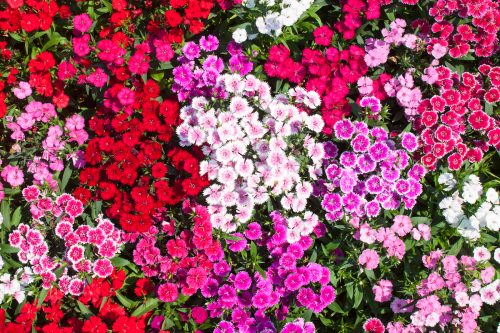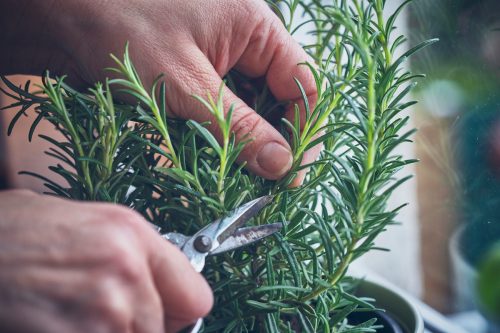9 Outdoor Plants That Will Make Your Garden Smell Amazing, Experts Say

“A garden is not only about visuals but also about creating an overall sensory experience,” says Bryan Clayton, CEO and co-founder of GreenPal. “A garden that smells as good as it looks can be a great source of joy and relaxation.” But too often, we get our plants home and they’re not fragrant at all. That’s why we consulted gardening experts to find out the best plants that smell good, whether you want a sweet, floral scent or something a bit more woodsy. Keep reading to find out which blooms will have your garden smelling amazing in no time.
READ THIS NEXT: 8 Easy Outdoor Plants That Don’t Need Sunlight.
1
Jasmine

Leading the pack of the best-smelling plants is jasmine, which, as Ben McInerney, a certified arborist and the founder of GoTreeQuotes, notes, is so aromatically pleasing that it’s often used in tea or car fresheners.
“Jasmine produces small white or yellow flowers with an intense, sweet fragrance,” says Benita Middleton, head gardener at Benita’s Garden Services. “It prefers full sun to partial shade and well-drained soil. Regular watering and occasional fertilization during the growing season can help maintain its health and encourage blooming.”
And what’s unique about jasmine is that it typically blooms and releases its scent in the evening, so it’s a lovely plant to have in your yard if you host a lot of dinner parties.
2
Lilac

Lilac bushes bloom for a very short window—only about two weeks in the spring, according to the Old Farmer’s Almanac—but they smell so good that it’s well worth the wait each year.
“Their scent is strong, sweet, and reminiscent of old-world charm,” describes Clayton. They need full sun, well-drained soil, and quite a bit of pruning.
“Lilacs also make for a great cut flower for spring and summer centerpieces,” adds Keegan Nesvacil, co-founder and CEO of Woodland Tools Co.
3
Sweet Alyssum

The name of this flowering plant was probably a giveaway that it’s sweet-smelling. “Its honey-scented flowers can create a carpet of fragrance in your garden,” shares Clayton.
Though you’ll often find its tiny white flowers used as a border plant, it also comes in shades of pink and purple.
“It’s a low-maintenance plant that doesn’t require excessive watering or fertilization,” says Middleton, but it’ll do best in full sun to partial shade.
READ THIS NEXT: 5 Plants That Will Keep Mosquitoes Out of Your Yard, According to Pest Experts.
4
Lavender

Unsurprisingly, lavender is also highly recommended by gardeners.
“Whether you’ve burned a lavender candle or used lavender-scented perfume, you’re [probably] familiar with the sweet, floral, herbal fragrance of lavender,” says McInerney.
This scent has a well-known calming effect, so consider planting lavender near your outdoor reading chaise or where you like to unwind with a glass of wine.
Lavender prefers full sun and regular pruning, but it’s drought-tolerant once established and doesn’t require frequent watering, says Middleton.
5
Roses

William Shakespeare’s famous line, “A rose by any other name would smell as sweet” only partially applies to actual roses. While these perennial flowers do all smell lovely, they don’t all smell the same.
“Roses are renowned for their diverse fragrances, which can range from fruity and citrusy to spicy and musky,” explains Middleton.
According to online flower delivery company Bouqs, darker-colored roses are more fragrant, and the more petals a rose has, the stronger it’ll smell.
“Red and pink roses tend to have a more traditional ‘rose’ smell. Yellow and white roses smell similar to violets, nasturtiums, or lemon. And orange roses have fragrances that could be compared to many fruits as well as orris root, nasturtium, violet, or clove,” Bouqs explains.
As for growing rose bushes, Nesvacil recommends planting them “in the spring after the last frost or at least six weeks before the first frost to give the roots time to establish before the plant goes dormant over the winter months.”
You’ll want to select a sunny spot in your garden and prune them regularly to “remove any dead or damaged parts of the plant that look brown,” Nesvacil adds.
6
Honeysuckle

Another flowering plant that has a strong smell in the evening is honeysuckle.
“Honeysuckle produces tubular, often two-lipped, flowers with a sweet and fruity fragrance,” says Middleton, adding that it prefers full sun to partial shade.
And since honeysuckle vines can spread quite a bit, she recommends regular pruning to “control its growth and encourage more blooms.” You may also want to provide support for the vines to climb.
For more garden advice delivered straight to your inbox, sign up for our daily newsletter.
7
Gardenia

An evergreen shrub, gardenia “is famous for its large, white, and highly fragrant flowers,” notes Middleton. “The scent is often described as sweet and exotic.”
But do keep in mind that this plant is a bit high-maintenance. “They prefer partial shade and acidic, well-drained soil, and require regular watering and fertilizer during the growing season,” says McInerney.
8
Dianthus

The scent of this flower isn’t exactly floral, so it may not be for everyone.
“Dianthus, also known as pinks or carnations, have flowers with a spicy, clove-like scent,” explains Middleton. “It’s a hardy perennial that can provide years of aromatic beauty.”
To keep this plant thriving, plant in full sun and regularly “deadhead spent flowers,” she says. According to Pennsylvania State University’s College of Agricultural Sciences, deadheading is a pruning process where “as blooms fade, pinch or cut off the flower stems below the spent flowers and just above the first set of full, healthy leaves.”
9
Rosemary

“Rosemary is a lovely aromatic herb that can fill a garden with a fresh, piney scent,” says Clayton. It can also assist you in cooking!
It prefers full sun and is “drought-tolerant and thrives in various climates,” he adds.